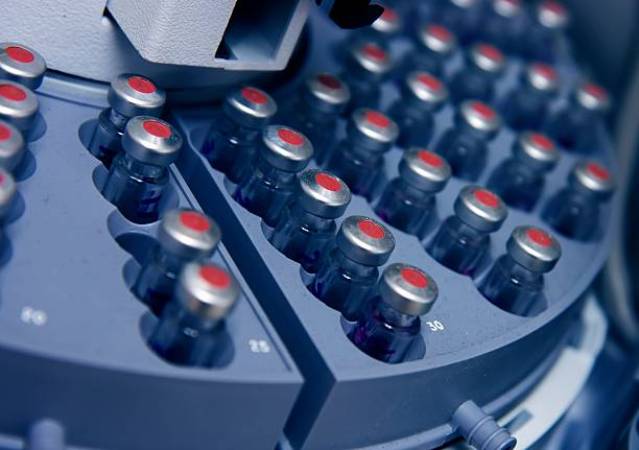high-performance liquid chromatography

High-overall performance liquid chromatography (HPLC),
previously called excessive-stress liquid chromatography, is a way in analytical
chemistry used to split, perceive, and quantify each issue in a combination. It
relies on pumps to skip a pressurized liquid solvent containing the pattern
aggregate via a column packed with a strong adsorbent fabric. Each thing within
the sample interacts slightly in a different way with the adsorbent fabric,
inflicting one-of-a-kind float rates for the one of a kind components and main
to the separation of the additives as they waft out of the column.
HPLC has been used for production (e.G., in the course of
the manufacturing method of pharmaceutical and biological products), felony
(e.G., detecting overall performance enhancement tablets in urine), research
(e.G., keeping apart the components of a complicated biological sample, or of
similar artificial chemical substances from every different), and clinical
(e.G., detecting diet D degrees in blood serum) purposes.
Chromatography can be defined as a mass transfer system
involving adsorption. HPLC is predicated on pumps to pass a pressurized liquid
and a pattern mixture via a column full of adsorbent, leading to the separation
of the pattern additives. The active aspect of the column, the adsorbent, is
typically a granular material fabricated from solid debris (e.G., silica,
polymers, etc.), 2–50 μm in length. The components of the pattern combination
are separated from every different because of their one of a kind tiers of
interaction with the adsorbent particles. The pressurized liquid is typically a
combination of solvents (e.G., liquid, acetonitrile and/or methanol) and is discussed
to as a "cellular segment". Its composition and temperature play a
major function within the separation system by using influencing the
interactions taking place among pattern additives and adsorbent. These
interactions are physical in nature, along with hydrophobic (dispersive),
dipole–dipole and ionic, most customarily a mixture.
HPLC is distinguished from conventional ("low pressure") liquid chromatography because operational pressures are drastically better (50–350 bar), even as everyday liquid chromatography normally is predicated on the pressure of gravity to bypass the itinerant phase through the column. Due to the small sample amount disconnected in analytical HPLC, usual column dimensions are 2.1–four.6 mm diameter, and 30–250 mm period. Also HPLC stakes are made with smaller adsorbent particles (2–50 μm in common particle length). This gives HPLC advanced resolving strength (the capability to distinguish among compounds) whilst separating combos, which makes it a popular chromatographic technique.
The schematic of an HPLC device usually consists of a
degasser, sampler, pumps, and a detector. The sampler brings the pattern
combination into the mobile section movement which carries it into the column.
The pumps supply the preferred drift and composition of the cell segment
through the column. The detector generates a signal proportionate to the
quantity of sample thing rising from the column, as a result allowing for
quantitative analysis of the sample additives. A virtual microprocessor and
person software program control the HPLC device and offer data analysis. Some
fashions of mechanical pumps in an HPLC device can mix multiple solvents
collectively in ratios changing in time, producing a composition gradient
inside the cell segment. Various detectors are in common use, along with
UV/Vis, photodiode array (PDA) or constructed on mass spectrometry. Most HPLC
gadgets also have a column oven that permits for adjusting the temperature at
which the separation is done.
The sample aggregate to be separated and analyzed is
brought, in a discrete small quantity (generally microliters), into the move of
mobile phase percolating thru the column. The components of the pattern move
via the column at one-of-a-kind velocities, which can be a feature of unique
physical interactions with the adsorbent (additionally called desk bound
segment). The pace of every factor depends on its chemical nature, on the
nature of the desk bound phase (column) and on the composition of the mobile
phase. The time at which a particular analyte elutes (begins from the column)
is called its retention time. The retention time measured underneath unique
situations is an figuring out characteristic of a given analyte.
Many one-of-a-kind sorts of columns are available, filled
with adsorbents varying in particle length, porosity, and surface chemistry.
The use of smaller particle length packing substances requires using better
operational strain ("backpressure") and typically improves
chromatographic resolution (the diploma of height separation among consecutive
analytes developed from the column). Sorbent constituent part may be
hydrophobic or polar in nature.
Common mobile phases used consist of any miscible amalgamation
of water with various organic solvents (the maximum common are acetonitrile and
methanol). Some HPLC strategies use water-loose mobile levels (see
everyday-section chromatography beneath). The aqueous issue of the cellular
section may contain acids (which include formic, phosphoric or trifluoroacetic
acid) or salts to help within the separation of the sample additives. The
composition of the cellular phase may be stored consistent ("isocratic
elution mode") or varied ("gradient elution mode") in the course
of the chromatographic analysis. Isocratic elution is commonly effective inside
the separation of sample additives which are very distinct in their affinity
for the desk bound segment. In hill elution the composition of the mobile
section is numerous normally from low to high eluting energy. The eluting
strength of the cellular segment is pondered by means of analyte retention
times with excessive eluting energy generating fast elution (=brief retention
times). A regular gradient profile in reversed phase chromatography might begin
at 5% acetonitrile (in water or aqueous buffer) and progress linearly to ninety
five% acetonitrile over five–25 mins. Periods of steady cellular section
composition can be part of any gradient profile. For instance, the cellular
segment composition can be stored steady at five% acetonitrile for 1–3 min,
observed via a linear exchange up to 95% acetonitrile.
The chosen composition of the cellular segment depends on
the intensity of interactions among diverse pattern additives
("analytes") and desk bound section (e.G., hydrophobic interactions
in reversed-segment HPLC). Conditional on their affinity for the stationary and
mobile levels, analytes partition between the 2 during the separation manner
taking place within the column. This partitioning technique is just like that
which occurs all through a liquid–liquid extraction but is continuous, now not
step-wise. In this case, the use of a water/acetonitrile gradient, extra
hydrophobic components will elute (come off the column) past due, as soon as
the cell section gets extra focused in acetonitrile (i.E., in a cellular section
of higher eluting energy).
The choice of cell phase additives, additives (including
salts or acids) and gradient conditions relies upon on the nature of the column
and pattern additives. Often a chain of trial runs is performed with the sample
if you want to discover the HPLC technique which gives ok separation.
Prior to HPLC scientists used preferred liquid
chromatographic techniques. Liquid chromatographic structures have been largely
inefficient because of the drift rate of solvents being dependent on gravity.
Separations took many hours, and on occasion days to finish. Gas chromatography
(GC) at the time changed into more effective than liquid chromatography (LC),
however, it was believed that gas section separation and evaluation of very
polar excessive molecular weight biopolymers become impossible. GC changed into
useless for plenty biochemists due to the thermal instability of the solutes.
As a end result, alternative techniques have been hypothesized which might soon
bring about the improvement of HPLC.
Following at the seminal work of Martin and Synge in 1941,
it turned into predicted through Calvin Giddings, Josef Huber, and others
within the Sixties that LC might be operated inside the high-performance mode
with the aid of lowering the packing-particle diameter appreciably under the
everyday LC (and GC) degree of 150 μm and using strain to growth the cell phase
pace. These predictions underwent big experimentation and refinement at some
stage in the 60s into the 70s. Early developmental studies started out to
enhance LC debris, and the discovery of Zipax, a superficially porous particle,
was promising for HPLC generation.
The Nineteen Seventies brought approximately many
developments in hardware and instrumentation. Researchers started out using
pumps and injectors to make a rudimentary layout of an HPLC machine. Gas
amplifier pumps were best due to the fact they operated at steady pressure and
did no longer require leak-loose seals or test valves for steady float and
desirable quantitation. Hardware milestones have been made at Dupont IPD
(Industrial Polymers Division) including a low-live-volume gradient tool being
utilized as well as changing the septum injector with a loop injection valve.
While instrumentational tendencies had been important, the records of HPLC is in most cases about the records and evolution of particle era. After the advent of porous layer particles, there was a consistent trend to reduced particle length to enhance performance. However, by means of reducing particle size, new problems arose. The sensible risks stem from the excessive pressure drop needed to pressure cellular fluid thru the column and the issue of making ready a uniform packing of extremely great substances. Every time particle length is decreased drastically, some other spherical of instrument improvement typically need to occur to address the pressure.


